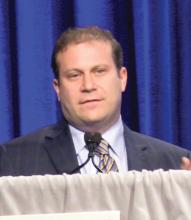MIAMI BEACH – You may soon be able to "pump up the volume" with a new facial filler, according to Dr. Nowell Solish.
Dr. Solish reported his experience with a low-molecular-weight, hyaluronic acid filler at the South Beach Symposium.
Allergan Inc.’s Voluma is already available in Canada and is expected to be available in the United States this year. This viscous formulation of the Juvéderm product line "is really for deeper injections and really for facial volume."
Appropriate use includes injections of the cheek, submalar region, and chin. "This is really for volume replacement in patients whose faces have become ‘bottom heavy,’ " said Dr. Solish of the division of dermatology at the University of Toronto.
"I use this in the midface mostly. It all depends on the age of the patient," he said. He tends to inject more filler medially for older patients and more laterally on the face for his younger patients.
Dr. Solish recommended injection planning using markings to ensure symmetrical placement of the filler. For example, he explained how a triangle on the midface created by the intersection of three straight lines could be used as a guide. One line would go from the lateral canthus to the corner of the patient’s mouth, the second from the upper part of the tragus to the alar lobule, and the third from the lateral canthus to the lower tragus.
Subcutaneous injections are made to the deep dermis and above the periosteum. Do not overcorrect your patient and always massage the area post injection to ensure even distribution, he said.
Voluma is expected to contain lidocaine when it is marketed in the United States. "I mix this filler with lidocaine. Voluma does not come with lidocaine in Canada," Dr. Solish said. He said that the addition of lidocaine with epinephrine makes the filler less viscous and easier to inject through a 28-gauge needle.
Results can last up to a year or longer. His patients typically return for subsequent treatment in 9-12 months. "We are finding they need about half as much product as their initial treatment," he said.
Dr. Solish reported side effects similar to other hyaluronic acid fillers, including bruising, swelling, and discomfort.
"But some patients have a foreign body–like reaction that requires draining and hyaluronidase," Dr. Solish said. "We’ve seen a few cases in Canada."
The low-molecular-weight hyaluronic acid is composed of 90% short molecular chains and 10% of the chains "you are used to with regular Juvéderm," Dr. Solish said.
The term "molecular weight" refers to the length of the molecular chains (number of repeating chains). Greater cross-linking with these shorter chains increases the product’s viscosity.
Dr. Solish disclosed being a consultant and researcher for Allergan.


